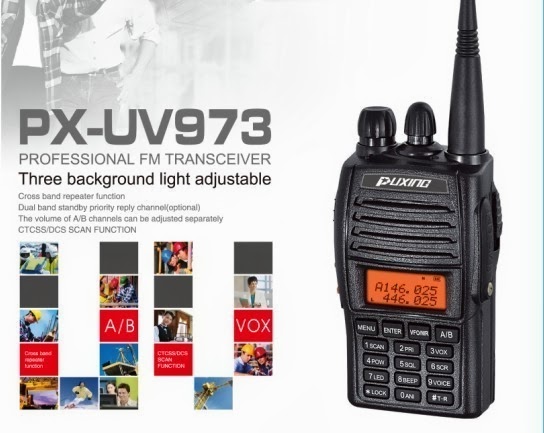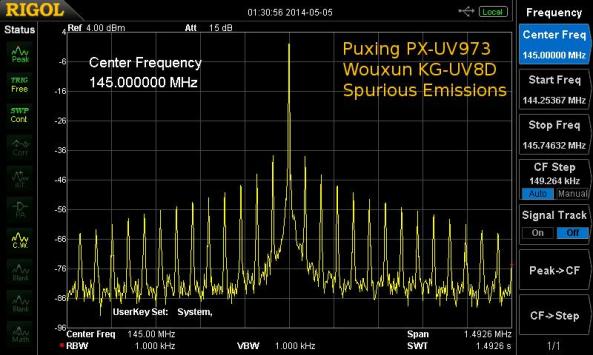Normally I review radios separately, but this time I will make an exception. Both the Puxing PX-UV973 and the Wouxun KG-UV8D are a new breed of Chinese radios. Both have two independent VFOs, both are cross-band capable. In part one I will discuss some of the gory details, but focus a bit more on theory.
Independent VFOs
In order to be cross-band capable, you need two independent VFOs. The idea itself is far from new: the Standard C520/C528, manufactured from 1989 until 1993, could do it too. The concept of independent VFOs and cross-band repeat capability was abandoned in favor of models with only one oscillator, which were much cheaper to produce. Modern radios are still dual-band, but can’t listen to both bands simultaneously, nor do cross-band repeat. Instead we got dual watch radios, which switch between both bands on regular intervals to check for activity.
Not only are dual band / dual watch radios much cheaper to produce, you will also avoid a number of technical pitfalls. Cramming two transceivers into one package is the easy part, making sure these two transceivers won’t influence each other in some negative way is another thing. That’s hard, very hard, especially when you combine two amateur bands like 2 meters and 70 centimeters. Ever calculated the third harmonics of 145 MHz?
Limited usability
 Cross-band capability makes sense in a number of situations, but in a hand held? A hand held is supposed to be just that – a portable transceiver. In the best of circumstances your little (negative gain) antenna will be about 2 meters above ground, in the worst case scenario (clipped to your belt) around 1 meter above ground. Cross-banding from such a low altitude is rather pointless.
Cross-band capability makes sense in a number of situations, but in a hand held? A hand held is supposed to be just that – a portable transceiver. In the best of circumstances your little (negative gain) antenna will be about 2 meters above ground, in the worst case scenario (clipped to your belt) around 1 meter above ground. Cross-banding from such a low altitude is rather pointless.
In order to put the system to good use, you will need to connect the radio to an outdoor antenna, preferably as high above ground as possible. In that respect a cross-band system is no different from a normal repeater system: antenna height is everything. While this will ensure that range problems will be solved, it might introduce another problem: receiver overload. Whether this is a problem or not depends on a lot of factors (design, RF pollution in the area), but so far all hand helds I’ve seen can’t match the filtering of most mobile radios.
Problem 1: harmonic suppression
If there’s any situation in which you don’t want to see harmonics at all, it is in these cross-band capable radios. To my surprise both Puxing as well as Wouxun nailed this.
– Puxing PX-UV973: -76dBc on VHF, -65dBc on UHF
– Wouxun KG-UV8D: -65dBc on VHF, -64dBc on UHF
Third harmonics and above undetectable.
Winner: Puxing.
Problem 2: sensitivity
A cross-band capable radio needs much better RX filtering. Better RX filters however will also introduce a certain amount of insertion loss. Because of this – and assuming both manufacturers did it right – I expected these radios to be less sensitive than we got used to.
– Puxing PX-UV973: -120 dBm on VHF, -120 dBm on UHF
– Wouxun KG-UV8D: -122 dBm on VHF, -121 dBm on UHF
Winner: Wouxun.
To put this in perspective: there have been a number of radios reviewed here what could pull of an astounding -129dBm. This means that both radios discussed here have sacrificed about 6dBm in order to get the filtering right. Before you look at these numbers in disgust: less sensitivity is far better than crappy filtering.
Problem 3: preventing both oscillators of interfering with each other
Here both radios fail miserably. For some reason both manufacturers weren’t able to to get this right, resulting in an awful lot of spurious emissions up and down the carrier.
The problem is most evident when you’re receiving around the third harmonics of your transmit frequency. Because my test frequencies are always 145 MHz and 435 MHz (mid-band for European hams), it was impossible to miss.
This is how 145 MHz signals looks like on the spectrum analyzer:
This image is valid for both radios. When you change the RX frequency, the distance between the peaks will change. When you lower the RX frequency enough the peaks will eventually disappear from the screen. Before you think that the problem is gone — nope. As soon as you adjust the frequency span of the analyzer, they’re back in town. The peaks got smaller and smaller eventually, but never disappeared completely.
This behavior is a problem, a really big problem. If you prefer clean signals under all conditions, these radios are not for you.
(to be continued)



Pingback: Comparatif du Puxing PX-UV973 vs Wouxun KG-UV8D | Radioamateurs-France
Another potential issue is overheating due to the high duty cycle when using cross-band repeat. I’m curious to learn how long they can be used for cross-band before they start to get to the point of overheating.
Looking forward to the rest of the review.
I’m VERY interested in the UV8D and especially how it might improve with future firmware updates. I assume this unit doesn’t allow for flashing as updates become available?
Thanks so much, I’m anxiously awaiting part two…
To the best of my knowledge firmware upgrades are not possible. Stay tuned.
What can you say about the characteristics of the UV8D standard antenna?
So far I’m comfortable saying that the stock antenna is as good as it gets.
You cannot alter antenna theory … A seven-inch antenna on a 2m/440 antenna all perform like any other seven-inch antenna: negative 3db or worse.
Exactly. A negative gain of about -6dB makes qualifies for a good antenna for an HT. Manufacturers don’t want you to know that though; most antennas are advertised as ‘Professional, high gain’ with 2.15 dBi gain.
I do not expect from her high gain, but I want to understand whether it makes sense to buy such antenna for UV6D?
Native uv6d antenna has a very high swr (about 3 -3.5) on both bands. and on 2m it has resonance at 156.8 (optimized on marine band?) and at a frequency of 145.5 swr reaches 5!
I’d also be curious how these HTs compare with dual band HTs from the big three (Yaesu, Icom and Kenwood). Are they as bad with spurious emissions as Wouxun and Puxing?
The crossband repeat functionality does make sense to me. I like that you can use it as a cheap, selfcontained, extremely compact and temporary repeater for other handhelds if you place it in a good location (tower/hill), preferably with a better seperate antenna.
I’m looking forward to reading the next part of the review.
Is there any chance these radios can work full-duplex, receiving with one VFO and transmitting with the other? This would be great for amateur satellite work. At this moment a second radio with headphones to avoid an audio feedback loop seems to be the solution if you want to hear the downlink signal while transmitting.
NO – although the UV973 is true dual-receive and will crossband repeat, it does not perform well in U/V nor V/U FM satellite modes. Neither does the new ‘8D from Wouxun. That should not really surprise anyone: I mean, Alinco could not get that engineering feat accomplished at the US$250 price point. Only Kenwood has their TH-D72 HT which performs well in V/U and U/V modes.
Could you elborate on this? Why doesn’t it work for full-duplex against a satellite?
Like the US$250 Alinco HT, sub-band receive specs/sensitivity are gruesome when programmed in V/U or U/V FM sat modes. Only the US$450 Kenwood HT does those modes well in a single HT.
What is the intermod performance of the Rigol you are measuring with ???
I am not too sure about your pictures… The fact you cannot measure harmonics above 3th means you have a crappy (chinese HAHA) spectrum analyser
Pedro ON7WP
Specs of the Rigol can be found online everywhere.
Are you going to donate a professional one to me? Brand new, of course, recently calibrated? 🙂
What do you think when you compare UV8d with UV6D? Which one do you prefer ?
Hey! What about a follow up on these reviews? I am looking for one unit with highest class and scrambler feature. Best regards and thanks for good reviews!!
hi, i also measured the KG-UV8D today wit R&S FSV4 spectrum analyzer. I cannot verify this problem you measured with the RIGOL. UV8D works ok for 2m and 70cm. 5.6W on 2m and 4.1W on 70cm. Harmonics are <-60dBc. 73 de OE2AIP
I have this radio and I suppose it has bad sensivity. Also I have wouxun uv6d and Bao uv b6, and it seems they show more better results.May be it is defect?
Question re KG-UVD8D crossband bi directional feature.
Can I set up VHF VFO with a local repeater pair ie 147.00 with minus 600 Offset and then a simplex UHF freq on the UHF VFO. ?
Purpose being to extend coverage of my local repeater inside my house.
UVD8 would be outside with good access to repeater. My UHF (VX-3 )would be used to access my local repeater via the UVD8 Cross Band feature.
Bit hard to explain – but can the unit be programmed to crossband repeat with one of the VFO’s operating in minus 600 split ?
Please delete my previous 2 comments and also this one. It follows the comment No.4 which you can publish if there isn’t any problem.
Thank you
73
A minor note:
“have sacrificed about 6dBm”
I think, it should be “6dB”, not “6dBm”.
dBm concerns comparison of a power level to 1mW. dBm expresses power.
dB concerns comparison between two values of a physical quantity. dB does not express power.
73
Hans, thanks for your in depth reviews. They are much more informative than informal and qualitative comments on most every other online source.
I tend to operate in noisy RF environments were selectivity is more important than sensitivity. Your review of the UVB5 tremendously helped me find a inexpensive radio with good performance in such an environment.
I recently purchased the UV8D. Can you provide any comments about the selectivity or phase noise of that receiver?
Thanks again! 73’s